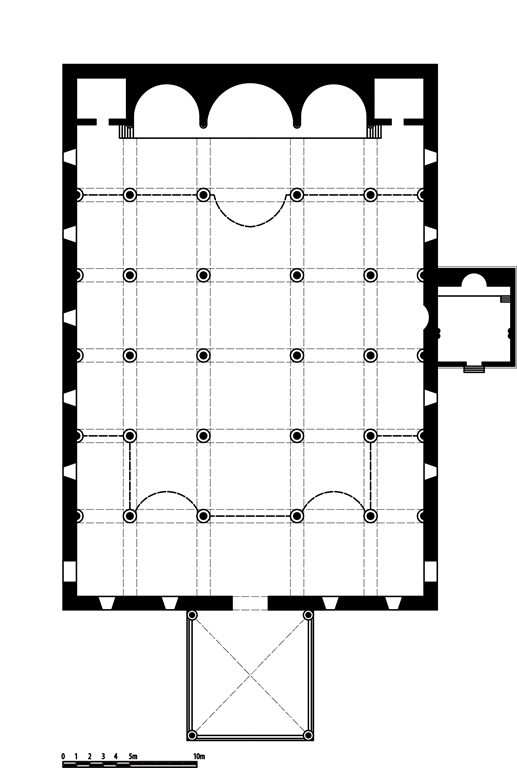The cathedral church of the Holy Mother of God in Garin/Erzurum, located at 39° 54' N and 41° 16' E, was built between 1838 and 1844, north of the city on the site of two older churches – known as the Upper and the Lower churches (Veri Zham and Vari Zham) – which were threatening to collapse.
With its 47 meters in length, including the bell tower, and its width of 27 m, this basilica is, with the church of Saint Cyriacus (Surp Guiragos) of Amida Dikranaguerd [Diyarbakır], restored and reopened for worship in 2011, one of the largest Armenian churches in the Eastern Ottoman provinces. Begun in 1838 by Father Bedros Altunian, the diocesan primate of Garin/Erzurum, the monument was completed by Bishop Ep‘rem Babayan, primate from 1840 to 1844. The first professional called upon for the construction was the architect Hovhannes Papazian, from Papert [Bayburt], before the job was ultimately given to the architect and builder (kalfa) Eranos of K‘sant‘a [***], who was from the same region.

Plan (after Kossian)
The church of the Holy Mother of God was a basilica with five naves and six bays resting on twenty monolithic columns and ten engaged pillars 4.5 m in height not including capital and base, erected on stonework foundations and closed with groin vaults. All arches were reinforced with iron rods and the walls were consolidated with clamps. The apse held three altars and two side chapels; a large tribune with balconies stood opposite, to the west, over the first bay with extensions over both ends of the second bay. The walls contained high windows surmounted by oculi; three iron doors, all giving onto the first bay, opened to the west, north and south. The wooden floor was preceded by a paved area under the tribune. The inside of the church was finished with a coating, the columns stuccoed, and against the south wall stood a pulpit of painted and gilded wood. The altar pieces, the apses and the north wall were hung with paintings and icons, among which one, in the southeast chapel, of the Virgin of the Seven Wounds, painted in 1820. The 1859 earthquake did not bring down the whole church, only the domed porch and bell tower that stood in front of the western door. These were rebuilt in 1869 and completed in 1879 by a wooden superstructure, all in the classical style of the three-tier Armenian bell towers with rotunda. The slight damaged to the church occasioned by the 1901 earthquake was quickly repaired.

Chapel ajoining the cathedral (Kossian, 1925-1926, vol. I, H.T.).
The south side of the cathedral church of Garin / Erzurum abutted a purportedly ancient chapel whose foundation is believed to date to the 7th century. Hence the dedication to the Holy Mother of God “affiliated”, which designated more specifically this oratory and its original outbuildings. The oratory had long been a revered pilgrimage site. It was restored in 1895-1897. It held paintings and silver objects; the old manuscripts for their part had been transferred in 1865 to the museum of the Ardznian school, founded in 1864 and situated opposite the church. In 1913, the school was transferred to a new building constructed to the south of the Armenian cemetery. The school’s collections included in particular 62 old manuscripts, the totality of which were in all likelihood destroyed in 1915.

Section
Confiscated after the Great War, the cathedral church of the Holy Mother of God in Garin / Erzurum was demolished at an unknown date. It stood on a vast tract of national land with an adjoining cemetery open to other Christian denominations, which the primate Maghakia Ormanian, later the Armenian patriarch of Constantinople (1896-1908), had planted with trees in 1882. Opposite was a hostelry (khan), which replaced the earlier Ardznian school in 1913. In 1915, the authorities uprooted the trees and carried off the cemetery stones to build an annex (a club) to the government palace. In a report dated September 1913, a diocesan commission had estimated the value of the Armenian national properties in the city at 100,000 Turkish gold pounds: cathedral church and chapel, prelacy, school buildings (five establishments), houses and shops, nearly all of which have disappeared. .
Ghazandjian, 1886, 44-45. Kossian, 1925-1926, I, 149-181. Kossian, 1964, [ix]. Thierry, 2005, 35-36.